What is the diamond and 1 defense
The diamond and 1 defense is a basketball defensive strategy and a junk defense which seeks to limit scoring opportunities, particularly for the opposing team’s best perimeter player, by implementing a combination of man to man and zone defense principles.
Additionally, the diamond and 1 defense is a variation of the box and 1 defense.
What is the primary objective of the diamond and 1 defense
The primary objective of the diamond and 1 defense is for the defensive team to allow their best defender to execute man to man pressure defense against the offensive team’s best player to limit or prevent the scoring and/or playmaking abilities of the same offensive player, especially near the perimeter.
Also, at the same time, the additional four defenders will play zone defense in the form of a diamond, hence the name of diamond and 1.
What is an example of the initial formation for the diamond and 1 defense
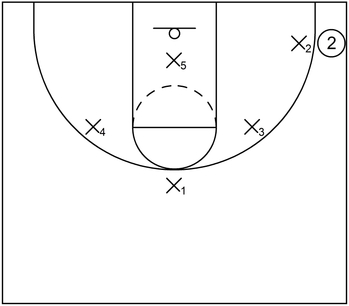
This is an example of the initial formation for the diamond and 1 defense. In this scenario, X2 is the chaser and therefore, guards the target, which is player 2, with man to man defense. Also, for this case, the target is in the right side corner.
The other four defenders form the diamond. Therefore, X1 is at the top of the diamond while X3 and X4 are near the high post elbows extended adjacent to the wings. Also, X5 is at the bottom of the diamond in the paint as well as in front of the basket.
What is the chaser in the diamond and 1 defense
In the diamond and 1 defense, the chaser is the defensive team’s best defender that will use man to man defensive principles against the offensive team’s best player, which could be simply referred to as the target.
Also, it should be noted that it would be more helpful if the chaser was not the defensive team’s best scorer when they received the ball on offense.
The reason for that is because the chaser could potentially use much energy guarding the opposing team’s best player.
This, in turn, could lead to offensive fatigue, which could hamper the chaser’s ability to score effectively and efficiently.
Moreover, the point guard or shooting guard should be designated as the chaser most of the time.
However, the chaser could also be a small forward or perhaps, even a power forward if those defenders are mobile enough to move on the perimeter consistently.
It is because small forwards and power forwards usually have longer arms than point guards or shooting guards, which could possibly make it easier to contest field goal attempts taken by the target.
Furthermore, if the defensive team has two or more above average defenders, then the coaching staff could switch out chasers periodically.
If that occurs, it would potentially frustrate the target because then, the target would have to adapt to a new defender in an effort to get open.
What are the general responsibilities of the chaser within the diamond and 1 defense
The general responsibilities of the chaser within the diamond and 1 defense would depend on whether the target has possession of the ball or not.
If the target has the ball
If the target has the ball, then the chaser will execute on-ball pressure defense without fouling to prevent easy scoring or playmaking opportunities for the target.
Additionally, it is equally important for the chaser to not reach in to steal the ball carelessly as this could also lead to undesirable fouls.
If the target does not have the ball
If the target does not have the ball, then the chaser will follow (or chase) the target from one area of the court to another.
It is also important to note that the chaser should not follow directly behind the target. Instead, the chaser should follow over the top (or high side) of the target, particularly if the target moves from baseline to baseline.
Moreover, the chaser should always try to implement denial defense to prevent the target from easily receiving the ball from other teammates on offense.
What are the general responsibilities of the zone defenders within the diamond and 1 defense
The responsibilities of the zone defender at the top of the diamond is to implement on-ball defensive pressure at the top if necessary or cover the high post area in general.
The responsibilities of the zone defenders near the high post elbow extended areas are to cover the wings and the corners.
The responsibilities of the zone defender at the bottom of the diamond is to guard against offensive players near the low post block or protect the basket in general.
What is an advantage of the diamond and 1 defense
One notable advantage of the diamond and 1 defense is that it could be beneficial against teams with more than one player that has the ability to shoot from the perimeter, particularly from three-point range.
This is also an interesting difference between the diamond and 1 defense and its counterpart box and 1 defense.
Essentially, the box and 1 defense is generally more useful if the offensive team primarily relies on one player, specifically a perimeter player such as a guard or wing, to score most of the team’s points.
However, the diamond and 1 defense could be more beneficial if the offensive team still needs one player to carry most of the scoring load but at the same time, there is at least one or two other perimeter players that can also score, especially from three-point range.
In other words, if an offensive team relies on one player to score most of the team’s points, but at the same time, there is at least one or two other catch-and-shoot type players, then the diamond and 1 defense might be useful.
The main reason why this is a factor is because with the diamond and 1 defense, three of the four zone defenders will typically cover the top, wings, and corners, which are the primary areas where certain players could potentially catch and shoot three-pointers.
What are disadvantages of the diamond and 1 defense
Disadvantage #1
One noteworthy disadvantage of the diamond and 1 defense is that there is a large gap in the middle of the zone, particularly near the high post and lane areas, similar to the box and 1 defense as well.
This basically means that if the offensive team is able to get the ball into the high post or into the lane, then the diamond and 1 defense would become susceptible to offensive tactics such as corner skip passes or high low action.
Disadvantage #2
Another disadvantage of the diamond and 1 defense to consider is that it is not very effective against an offensive team with more than one above average low post players.
Essentially, in the diamond and 1 defense, the bottom zone defender is the primary defender that protects the basket at all times.
Therefore, if an offensive team has more than one above average low post player, then this could potentially put tremendous pressure on the bottom zone defender.
In other words, if the offensive team put two of their best post players on each low post block, then the bottom zone defender would have to try and guard two people. This, in turn, would most likely be a disaster for the defense.
Once again, if that were the case, then the defensive team should possibly consider man to man defense or another zone defense.
Disadvantage #3
A third disadvantage of the diamond and 1 defense is that the two of the zone defenders, particularly near the high post elbows have to cover two respective areas on each side of the court: the wings and the corners.
This basically means that those two defenders will need an adequate amount of footspeed to sprint the distance between the wings and the corners.
If those two defenders have less than average footspeed and quickness, then this could lead to uncontested jump shots, especially in the corners.
What are examples of defensive rotations for the diamond and 1 defense
Example 1
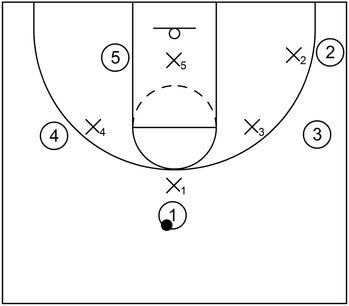
This is an example of the diamond and 1 defense when the ball is at the top. X1 executes defensive pressure against 1 at the top. X3 and X4 could stay within the three-point arc or deny the passes to the wings.
X2 covers 2 with man to man defense near the corner while X5 simply protects the basket at the bottom of the diamond.
Example 2
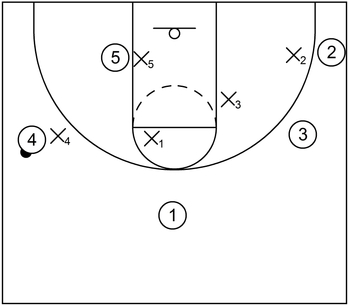
This is an example of the diamond and 1 defense when the ball is on the wing. When that occurs, X4 executes on-ball defensive pressure while X1 drops back to cover the high post, particularly near the left side elbow.
X5 could either front the low post or execute standard low post defense against 5 while X3 drops back near the right side mid-post area to provide weak side help defense. X2 continues to cover 2 with man to man defense.
It should also be noted that because there is an empty corner, X4 can play straight on-ball defense with the proper defensive stance. That is to say, X4 could align themselves evenly with the offensive player, which is 4.
In other words, X4 does not have to necessarily force the offensive player to the baseline or towards the middle.
However, if the corner was filled by an offensive player that is not the target, then X4 would have to take a difference approach which is explained more in Example #6 below.
Example 3
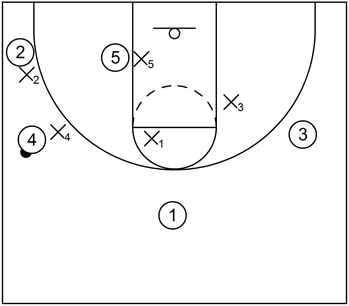
This is another example of the diamond and 1 defense when the ball is on the wing. However, this time, player 2, which is the target, cut through to the left side corner.
When that occurs, X2 executes denial defense to prevent 2 from easily receiving the ball from 4. The other defenders execute the same defensive principles as previously.
Example 4
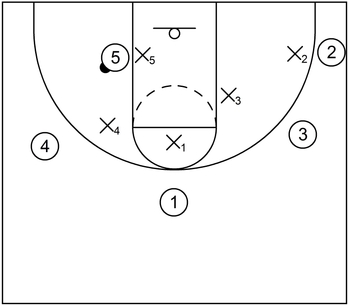
This is an example of the diamond and 1 defense when the ball gets into the low post. When that happens, X5 could execute standard low post defense while X4 stands near the gap between the wing and the low post.
Essentially, X4 as well as X5 are basically playing man to man defense. So, if 4 were to cut down to the corner, X4 would simply follow because X4 would have to guard the corner anyway.
X1 drops back to cover the middle of the high post, which in this case, is also referred to as the nail area.
X3 continues to provide weak side defense near the mid-post. Also, for this example, X3 is on a direct line between 3 and 5. Therefore, if 5 were to execute a skip pass to 3, then X3 could possibly deflect or intercept that pass.
Furthermore, if that did not work, then X3 would still be in a good position to execute a closeout on 3 if necessary. As for the chaser, X2 continues to cover the target, which is 2.
Example 5
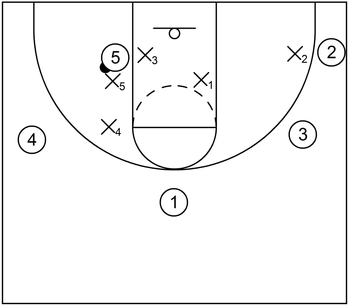
This is another example of the diamond and 1 defense when the ball gets into the low post. However, this time, it features double team action.
Basically, X3 could sprint across the lane to execute a double team alongside X5. When that occurs, X4 continues to stand near the gap between the ball side low and the wing.
At the same time, X1 drops far down into the lane below the dotted half circle to limit a potential cut by 1 and to provide weak side coverage against 3. X2 continues to deny 2 from receiving the ball on the weak side.
Example 6
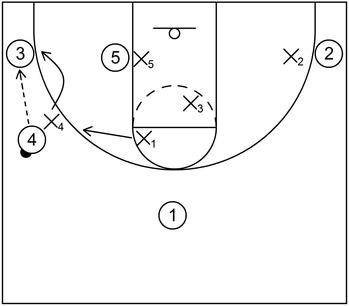
This is an example of the diamond and 1 defense when the ball is in the corner, particularly via a direct pass from the ball side wing.
Prior to the pass, 3 cut through to the left side corner. When that occurs, X4 has to take one or two steps towards the ball side corner and have their left foot (i.e. the inside foot of X4) adjacent to the left foot of 4 (i.e. the outside foot of 4).
This means that X4 has to open up and give 4 the opportunity to dribble towards the middle but if that occurred, X1 is initially near the high post elbow to provide help defense.
Furthermore, and more importantly, when X4 opens up, this allows X4 to get to the corner much quicker than if X4 just played straight on-ball defense.
Therefore, when 3 is in the process of receiving the ball from 4, on the air time of the pass, X4 should still be to closeout and take away potential uncontested jump shots or dribble drive opportunities for 3.
This, of course, assumes that X4 has an ample amount of speed and quickness to sprint between the wing and corner in the first place. Otherwise, 3 would probably have an open jump shot or dribble drive opportunity.
Moreover, when 3 receives the ball and X4 is able to closeout, X1 slides toward the left side wing while X5 fronts the low post or executes standard low post defense.
X3 can also slide into the lane near the weak side to limit the potential basket cut by 1 while X2 continues to deny 2 from receiving the ball.